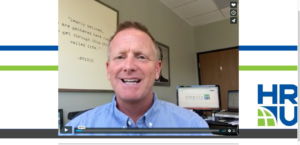Today on the Weekly Dose I take a look at Eightfold. Eightfold.ai is a recruiting technology that kind of is hard to define, like many of the new AI-driven technologies within the TA space right now. Eightfold does automated matching of candidates to your jobs with rankings, it can build personalized career sites, help eliminate hiring and screening biases, and even be used for internal mobility.
See what I what I mean? What do you call that? They call it a talent intelligent platform. It can integrate with your ATS and/or CRM and help you automate much of the front-side of your recruiting screening and matching process.
What I find in most organizations is we have recruiters, and they might be really good at the job of recruiting, but they don’t have the specialized knowledge to truly know what candidate will be better at a certain job than another because they lack the technical skill knowledge. Eightfold uses AI and deep learning to match candidates much more accurately and quickly than a human recruiter can do.
The process of Eightfold is fairly lightweight. They can pull in your jobs from your ATS or you can create a job in Eightfold and it will go to work ranking candidates who are the best fit and most likely to respond to the job you have open. This gives an instant target list for your recruiters to go after.
What do I like about Eightfold?
– Eightfold can help organizations better leverage the resources and data they have invested in talent attraction that has previously not been available to most organizations. Technology like Eightfold will move organizations faster, but also with a higher quality of hire.
– Eightfold personalizes the career site experience for candidates who are coming to your site. Candidate has the ability to upload their resume/application and immediately get a personalized experience that is different from the next candidate who comes to your site.
– Eightfold will help organizations do a better job at hiring for diversity by masking certain information on profiles, but also delivery funnel diversity statistics so TA leaders can have a real-time view of diversity pipelines within the organizations and see where diverse candidates are falling through.
– Because Eightfold’s match technology is so robust, organizations are using it for internal mobility as well, but uploading all of their internal talent and giving a view to leaders of the organization of where you might already have someone internally who is the best fit for a position, and should go down that path first, before looking externally. Too often we see great talent turnover because a position was filled from the outside, and they were never even considered for it, and didn’t even realize it was a possibility.
This type of technology can be used across all kinds of industries, not just tech. From a cost standpoint, and a data standpoint, it works much better at larger volumes, so you’re probably looking for at least 500+ employee organizations to be most effective. It’s certainly dynamic and eye-opening when you demo and I encourage to take a look! While there is an investment to get technology like Eightfold, the ROI is huge in comparison to hiring another recruiter or sourcing pro.
 The Weekly Dose – is a weekly series here at The Project to educate and inform everyone who stops by on a daily/weekly basis on some great recruiting and sourcing technologies that are on the market. None of the companies who I highlight are paying me for this promotion. There are so many really cool things going on in the tech space and I wanted to educate myself and share what I find. If you want to be on The Weekly Dose – just send me a note – timsackett@comcast.net
The Weekly Dose – is a weekly series here at The Project to educate and inform everyone who stops by on a daily/weekly basis on some great recruiting and sourcing technologies that are on the market. None of the companies who I highlight are paying me for this promotion. There are so many really cool things going on in the tech space and I wanted to educate myself and share what I find. If you want to be on The Weekly Dose – just send me a note – timsackett@comcast.net
Want help with your HR & TA Tech company – send me a message about my HR Tech Advisory Board experience.

